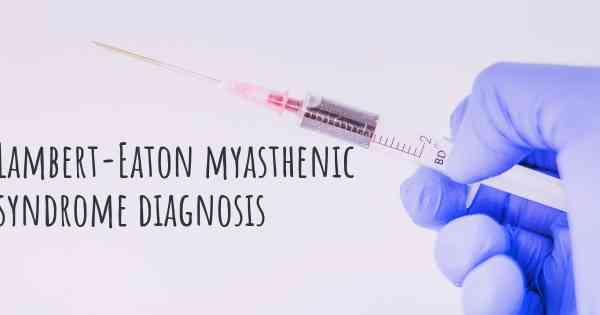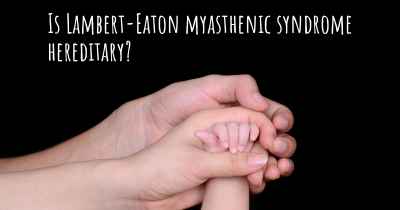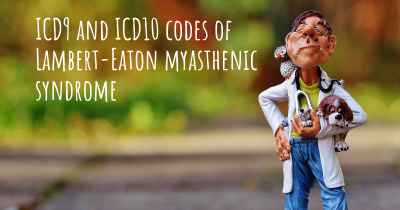How is Lambert-Eaton myasthenic syndrome diagnosed?
See how Lambert-Eaton myasthenic syndrome is diagnosed. Which specialists are essential to meet, what tests are needed and other useful information for the diagnosis of Lambert-Eaton myasthenic syndrome

Diagnosis of Lambert-Eaton Myasthenic Syndrome (LEMS)
Lambert-Eaton myasthenic syndrome (LEMS) is a rare autoimmune disorder that affects the neuromuscular junction, leading to muscle weakness and fatigue. Diagnosing LEMS can be challenging due to its similarity to other neuromuscular disorders. However, with a comprehensive evaluation, including medical history, physical examination, and specific diagnostic tests, healthcare professionals can accurately diagnose LEMS.
Medical History
The first step in diagnosing LEMS is obtaining a detailed medical history from the patient. The healthcare provider will ask about the onset and progression of symptoms, including muscle weakness, fatigue, and autonomic dysfunction. They will also inquire about any underlying medical conditions, such as small cell lung cancer (SCLC), which is strongly associated with LEMS.
Physical Examination
During the physical examination, the healthcare provider will assess the patient's muscle strength, reflexes, and coordination. They will look for characteristic signs of LEMS, such as proximal muscle weakness (affecting the muscles closer to the trunk), reduced deep tendon reflexes, and autonomic dysfunction (e.g., dry mouth, constipation, or erectile dysfunction).
Electromyography (EMG)
Electromyography (EMG) is a key diagnostic test for LEMS. It involves inserting a fine needle electrode into the affected muscles to measure their electrical activity. In LEMS, EMG typically shows a characteristic pattern called "incremental response." This means that the muscle's response to repetitive nerve stimulation improves with each subsequent stimulus, indicating a defect in the neuromuscular junction.
Nerve Conduction Studies (NCS)
Nerve conduction studies (NCS) are often performed alongside EMG to evaluate the electrical conduction of nerves. In LEMS, NCS may show reduced compound muscle action potentials (CMAPs) or prolonged latencies, indicating impaired nerve function.
Autoantibody Testing
Autoantibody testing plays a crucial role in diagnosing LEMS. The majority of LEMS cases are associated with antibodies targeting the voltage-gated calcium channels (VGCCs) on the presynaptic membrane of nerve terminals. The most common antibody is called P/Q-type VGCC antibody. Blood tests can detect these autoantibodies, confirming the diagnosis of LEMS.
Repetitive Nerve Stimulation (RNS)
Repetitive nerve stimulation (RNS) is another important test used to diagnose LEMS. It involves delivering repetitive electrical stimuli to a nerve and measuring the muscle's response. In LEMS, RNS typically shows a characteristic "incremental response" or an increase in the muscle's response with repeated stimulation. This response is due to the impaired release of acetylcholine, the neurotransmitter responsible for muscle contraction, at the neuromuscular junction.
Additional Investigations
In some cases, additional investigations may be necessary to confirm the diagnosis of LEMS or identify any underlying conditions. These may include:
- Chest imaging: Chest X-ray or computed tomography (CT) scan may be performed to screen for small cell lung cancer (SCLC), which is strongly associated with LEMS.
- Autoimmune panel: Blood tests may be conducted to evaluate for other autoimmune disorders that can present with similar symptoms.
- Neuromuscular biopsy: In rare cases, a muscle biopsy may be performed to examine the muscle tissue under a microscope and rule out other neuromuscular conditions.
Consultation with Specialists
Given the complexity of LEMS diagnosis, consultation with specialists, such as neurologists or neuromuscular experts, is often sought. These specialists have extensive knowledge and experience in diagnosing and managing neuromuscular disorders, including LEMS.
Conclusion
Diagnosing Lambert-Eaton myasthenic syndrome (LEMS) requires a comprehensive evaluation, including medical history, physical examination, and specific diagnostic tests. The key diagnostic tests for LEMS include electromyography (EMG), nerve conduction studies (NCS), autoantibody testing, and repetitive nerve stimulation (RNS). Additional investigations, such as chest imaging and autoimmune panels, may be necessary to confirm the diagnosis or identify underlying conditions. Consultation with specialists can further aid in the accurate diagnosis of LEMS.








